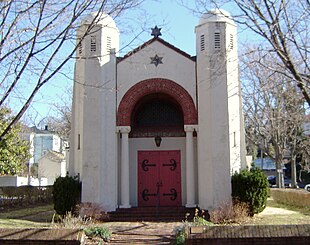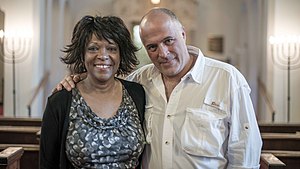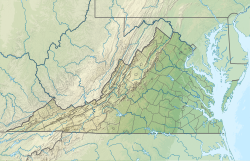Temple House of Israel

| Temple House of Israel | |
|---|---|
 Temple House of Israel synagogue | |
| Religion | |
| Affiliation | Reform Judaism |
| Ecclesiastical or organizational status | Synagogue |
| Leadership | Rabbi Randi Nagel |
| Status | Active |
| Religious features | Charles Connick glass screen |
| Location | |
| Location | 15 North Market Street, Staunton, Virginia |
| Country | United States |
Location in Virginia | |
| Geographic coordinates | 38°09′17″N 79°04′16″W / 38.154709°N 79.071198°W |
| Architecture | |
| Architect(s) |
|
| Type | Synagogue |
| Style | Moorish Revival |
| Founder | Major Alexander Hart |
| Date established | 1876 (as a congregation) |
| Completed | 1925 |
| Materials | Mercer tiles |
| Website | |
| thoi | |
| Part of | Gospel Hill Historic District (ID85000299) |
| Designated CP | February 14, 1985 |
| [1][2] | |
Temple House of Israel is a Reform Jewish congregation and synagogue located at 15 North Market Street, in Staunton, Virginia, in the United States.[3] Founded in 1876 by Major Alexander Hart,[4] it originally held services in members' homes, then moved to a building on Kalorama street in 1885, the year it joined the Union for Reform Judaism.[2]
In 1925 the congregation constructed its current building at 115 North Market Street,[2] a contributing property to the Gospel Hill historic district.[5] The Moorish Revival structure was designed by Sam Collins of T.J. Collins and son, and includes Mercer tiles, and windows and a glass screen by Charles Connick of Boston.[1]
As of 2019[update], Rabbi Randi Nagel served Temple House of Israel as rabbi.[6]
Early history
[edit]Temple House of Israel was founded in 1876 in Staunton, Virginia by Major Alexander Hart,[4] who had fought for the Confederate States of America in the American Civil War.[7] Hart served as the congregation's president and minister until at least 1893.[7][8]
Services were held in members' homes for more than eight years. In 1884 the congregation acquired the Hoover School building at 200 Kalorama Street,[2] at the corner of Market Street,[9] and in February 1885 began holding services there.[2] The building still stands, diagonally opposite the Hotel 24 South. That same year the synagogue joined the Union of American Hebrew Congregations (now the Union for Reform Judaism).[2]
The congregation purchased land north of Staunton for a cemetery in 1886, and held its first burial there in 1887. The cemetery, on North Augusta Street between Woodland Drive and Lee Street, is still used for burials today.[2][10]
At the turn of the 20th century, House of Israel had no rabbi, but held services twice a week, Friday nights from 8:00 to 9:00 pm, and Saturday from 10:30 to 11:30 am. The congregation also ran a religious school.[11] By 1907 Staunton's Jewish population was an estimated 40 people. House of Israel had fifteen member families, and still held services twice a week. However, the congregation still had no rabbi, and the religious school no longer functioned.[12]
Fannie Barth Strauss, instructor and later assistant professor of Latin and German at Mary Baldwin College from 1918 to 1954, re-established the Hebrew school at House of Israel in 1916.[13] In 1919, though the synagogue still had no rabbi, the school held classes once a week, and had two teachers and twelve students.[14] Strauss would serve as the school's principal from its re-establishment until at least 1964, and also served as the synagogue's treasurer from 1946 until at least 1964.[13]
Move to Market Street
[edit]By 1924 the congregation had outgrown its Kalorama Street building, and it purchased a lot at 115 North Market Street from Mary Baldwin College for $7,150 (today $127,000).[2][3] Sam Collins of T.J. Collins and son designed a new Moorish Revival building there,[1][2] constructed at a cost of $17,000 (today $295,000).[2]
The one-story stucco building had a twin gable roof with 3 bays. Decorated with "Early Assyrian motifs", the facade presented "[f]lanking twin towers with suppressed buttresses", and a "[l]arge arched opening in [the] central bay, supported by unusual columns",[5] and included Mercer tiles.[1] All the windows, and a glass screen, were created by Charles Jay Connick of Boston,[1] who also created famous windows for a number of religious buildings, including the rose windows of St. Patrick's Cathedral and the Cathedral of Saint John the Divine in New York City.[5] The windows (sixteen in total) and screen cost $700 (today $12,000), and featured fruits or plants grown in the Land of Israel, including "olives, grapes, citron, pomegranate, and others".[2]
In 1947, a kitchen and small social hall were constructed at the back of the building, and a south bay was added to the sanctuary; Sam Collins was again the architect.[2] To provide more room for the religious school, the social hall was expanded in 1965.[2] The building was a contributing property to the successful 1984 National Register of Historic Places nomination of Gospel Hill as a historic district.[5]
During the early 1970s, Frank M. Waldorf was the congregation's rabbi. He went on to serve for 30 years as rabbi at Temple Sinai in Brookline, Massachusetts.[15] After Waldorf, Temple House of Israel entered into a "joint rabbi" arrangement with Congregation Beth El of Harrisonburg, Virginia, where rabbis would serve for two-thirds of their time at Beth El, and the rest at House of Israel.[16] The first rabbi hired under this arrangement was Robert Kraus (also in the early 1970s).[16]
1980s to present
[edit]The congregation remained small; in 1983, membership was only 28 families.[17] That year Douglas D. Weber was hired as rabbi of both Temple House of Israel and Beth El, and the "joint rabbi" arrangement became "permanent".[18][16] From 1984 to 1988 Lynne Landsberg filled that role.[19][20] The 30th female rabbinic graduate of the Union for Reform Judaism,[19][20] she had previously served as student rabbi at Temple House of Israel from 1979 to 1981, then as associate rabbi of Manhattan's Central Synagogue until 1984.[21] She subsequently took on a number of roles at the Union for Reform Judaism, and, after a serious and disabling accident in 1999, became the senior adviser on disability issues at the Religious Action Center for Reform Judaism.[19][20][21]
Rabbis Daniel Fink and Laura Rappaport jointly led Temple House of Israel and Beth El from 1988 to 1992.[16] During the 1990s the two congregations were served by Jonathan Biatch, then Jacqueline Romm Satlow,[16][22] followed, from 1997 to 2003, by Ariel J. Friedlander as rabbi.[16]

In 2003, Joe Blair became the rabbi of Temple House of Israel and Beth El;[23] the two congregations combined had 120 member families.[24][25] Blair received B.A. and Master of Computer Science degrees from the University of Virginia, and a Juris Doctor from The College of William & Mary Law School.[26] After working in the computer field for 15 years, and briefly as a general practice attorney, he returned to school, attending the Reconstructionist Rabbinical College, from which he graduated with a Masters in Hebrew Letters in 1996.[27] In 2004 he was appointed an adjunct professor of religion at Mary Baldwin College.[26] A member of Toastmasters International, to which he attributed his speaking abilities,[28] he also moderated a conversion forum on Jewish.com.[29] In 2008 Blair was one of 18 rabbis chosen nationally to participate in the Synagogues: Transformation and Renewal elite training program.[24][30] Blair left Temple House of Israel in 2018, to become the rabbi of Temple Israel of Charleston, West Virginia.[31]
Peter Grumbacher joined as part-time interim rabbi in 2018.[32] After receiving his ordination from Hebrew Union College-Jewish Institute of Religion in 1972, he served as full-time rabbi of Congregation Beth Emeth in Wilmington, Delaware until his retirement in 2009, and subsequently as interim rabbi of Beth El Congregation in Winchester, Virginia.[33] Rabbi Randi Nagel was elected as Rabbi of the congregation in 2019.[6]
On film
[edit]Temple House of Israel served as a location for the documentary film Rita Dove: An American Poet produced by Heritage Film Project. Filming took place in December 2013.[34]
Notes
[edit]- ^ a b c d e Troubetzkoy (2004), p. 112.
- ^ a b c d e f g h i j k l m Our History, Temple House of Israel website.
- ^ a b Temple House of Israel website.
- ^ a b Encyclopedia Judaica, Vol. 16, p. 164.
- ^ a b c d Gospel Hill Historic District Nomination Form, National Register of Historic Places, p. 26.
- ^ a b "RABBI NAGEL". THOI. 8 April 2013. Retrieved 2020-04-01.
- ^ a b Rosen (2000), p. 362.
- ^ Ginsberg (1969), p. 85.
- ^ American Jewish Year Book, Vol. 1, p. 267.
- ^ Staunton: Augusta County, International Association of Jewish Genealogical Societies website.
- ^ American Jewish Year Book, Vol. 2, p. 482.
- ^ American Jewish Year Book, Vol. 9, p. 422.
- ^ a b Morton (1964), p. 965.
- ^ American Jewish Year Book, Vol. 21, p. 576.
- ^ Rabbi Emeritus Frank M. Waldorf, Temple Sinai Brookline website.
- ^ a b c d e f Harrisonburg, Virginia, Institute of Southern Jewish Life (2017).
- ^ Rosen (1983), p. 419.
- ^ Central Conference of American Rabbis Ninety-Third Annual Convention (1984), p. 410.
- ^ a b c Amann (2005).
- ^ a b c Rabbi Lynn F. Landsberg, St. James Episcopal Church of Richmond Virginia website.
- ^ a b Calello (2017)
- ^ Clergy, Temple Beth El Madison website.
- ^ Meet the Rabbi, Beth El Congregation website.
- ^ a b Mitchell (2008-07-19).
- ^ About us, Temple House of Israel website.
- ^ a b MBC news, October 12, 2004.
- ^ Meet Rabbi Joe Blair, Temple House of Israel website.
- ^ Bowman (2006).
- ^ Trent (2008).
- ^ Graham (2008-07-03).
- ^ Kersey (2018).
- ^ Calello (2018).
- ^ Rabbi Grumbacher, Temple House of Israel website.
- ^ Montes-Bradley.
References
[edit]- Amann, Paula. "A life reclaimed. Mending from injuries, rabbi champions disabled", Washington Jewish Week, July 17, 2005.
- American Jewish Committee. ""Directory of Local Organizations"" (PDF). Archived from the original (PDF) on 2011-07-23. (2.12 MB), American Jewish Year Book, Jewish Publication Society, Volume 1 (1899–1900).
- American Jewish Committee. ""Local Jewish Life"" (PDF). (5.54 MB), American Jewish Year Book, Jewish Publication Society, Volume 2 (1900–1901).
- American Jewish Committee. ""Assorted Statistics"" (PDF). (7.72 MB), American Jewish Year Book, Jewish Publication Society, Volume 9 (1907–1908).
- American Jewish Committee. ""Directories"" (PDF). (6.06 MB), American Jewish Year Book, Jewish Publication Society, Volume 21 (1919–1920).
- Meet the rabbi, Beth El Congregation of Harrisonburg Virginia website. Accessed March 27, 2019.
- Bowman, Rachel. "Address The Fear. Toastmasters Club Helps Novices Become Confident Speakers", The Daily News-Record, February 7, 2006.
- Calello, Monique. "She fought for rights of the disabled, then was disabled in a car crash. It didn’t stop her.", The News Leader, July 27, 2017.
- Calello, Monique. "Rabbi talks about the night his father was arrested by the Gestapo", The News Leader, October 19, 2018.
- Central Conference of American Rabbis Ninety-Third Annual Convention, Central Conference of American Rabbis, Edition 93, 1984. ISBN 978-0-916694-93-7
- Encyclopaedia Judaica, Volume 16, Keter Publishing House, 1972.
- Ginsberg, Louis. Chapters on the Jews of Virginia, 1658-1900, Cavalier Press, 1969.
- Graham, Chris. "Local rabbi selected for national program", August Free Press, July 3, 2008.
- Staunton: Augusta County, International Jewish Cemetery Project, International Association of Jewish Genealogical Societies website. Accessed July 4, 2010.
- Harrisonburg, Virginia, Goldring / Woldenberg Institute of Southern Jewish Life, History Department, Encyclopedia, Tennessee, Memphis, 2017. Accessed March 28, 2019.
- Kersey, Lori. Temple Israel's new rabbi reflects on political climate, move to Charleston, Charleston Gazette-Mail, July 15, 2018.
- "MBC Appoints New Faculty Members", MBC News, Mary Baldwin College website, October 12, 2004. Accessed July 4, 2010.
- Mitchell, Tom. "Blair Selected For National Mentoring Program", The Daily News-Record, July 19, 2008.
- Montes-Bradley, Eduardo. Rita Dove: An American Poet, Vimeo. Accessed March 27, 2019.
- Morton, Richard Lee. Virginia Lives: The Old Dominion Who's Who, Historical Record Association, 1964.
- "Gospel Hill Historic District Nomination Form" (PDF). (6.63 MB), National Register of Historic Places, continuation sheet 56.
- Rosen, Robert N. The Jewish Confederates, University of South Carolina Press, 2000. ISBN 978-1-57003-363-6
- Rosen, Oded. The Encyclopedia of Jewish Institutions: United States & Canada, Mosadot Publications, 1983.
- Rabbi Lynn F. Landsberg, WomanKind, St. James Episcopal Church of Richmond Virginia website. Accessed July 4, 2010.
- Clergy, Temple Beth El Madison website. Accessed July 4, 2010.
- Temple House of Israel website. Accessed July 4, 2010.
- About us, Temple House of Israel website. Accessed July 4, 2010.
- Meet Rabbi Joe Blair, Temple House of Israel website. Accessed July 4, 2010.
- Our History, Temple House of Israel website. Accessed March 27, 2019.
- Our Part-time Interim Rabbi Peter Grumbacher, Temple House of Israel website. Accessed March 27, 2019.
- Rabbi Emeritus Frank M. Waldorf, Clergy, Prior rabbis, Temple Sinai Brookline website. Accessed July 4, 2010.
- Trent, C.J. "Found: Jewish Soul. Journey to Judaism through Conversion", Jewish Post of New York, May 15, 2008.
- Troubetzkoy, Sergei. Staunton, Arcadia Publishing, 2004. ISBN 978-0-7385-1697-4
External links
[edit]- Official website
- "Hanukkah", The News Virginian, December 20, 2008.
